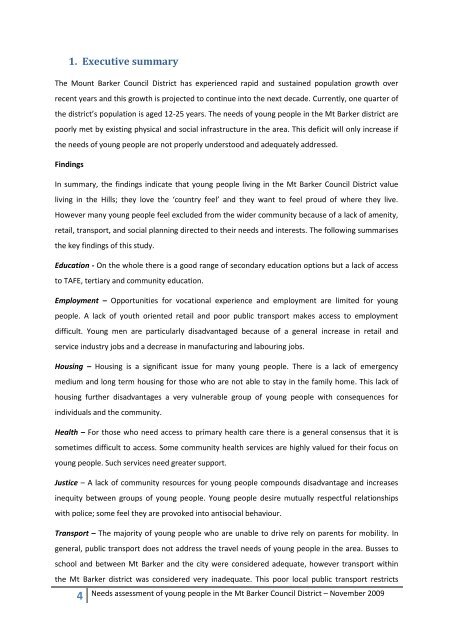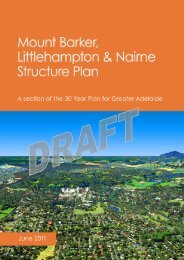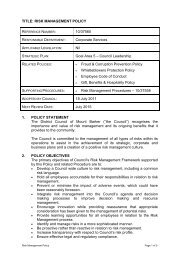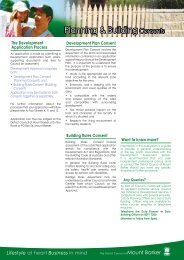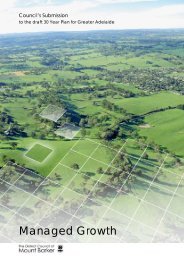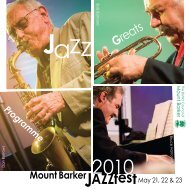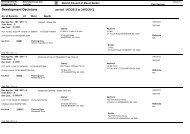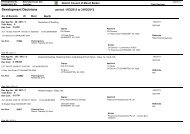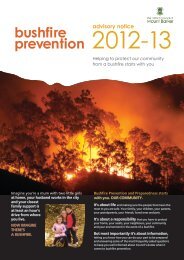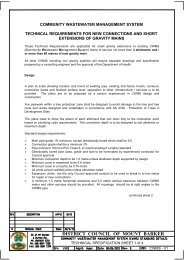Youth Research Qualitative Report - District Council of Mount Barker
Youth Research Qualitative Report - District Council of Mount Barker
Youth Research Qualitative Report - District Council of Mount Barker
You also want an ePaper? Increase the reach of your titles
YUMPU automatically turns print PDFs into web optimized ePapers that Google loves.
1. Executive summary<br />
The <strong>Mount</strong> <strong>Barker</strong> <strong>Council</strong> <strong>District</strong> has experienced rapid and sustained population growth over<br />
recent years and this growth is projected to continue into the next decade. Currently, one quarter <strong>of</strong><br />
the district’s population is aged 12-25 years. The needs <strong>of</strong> young people in the Mt <strong>Barker</strong> district are<br />
poorly met by existing physical and social infrastructure in the area. This deficit will only increase if<br />
the needs <strong>of</strong> young people are not properly understood and adequately addressed.<br />
Findings<br />
In summary, the findings indicate that young people living in the Mt <strong>Barker</strong> <strong>Council</strong> <strong>District</strong> value<br />
living in the Hills; they love the ‘country feel’ and they want to feel proud <strong>of</strong> where they live.<br />
However many young people feel excluded from the wider community because <strong>of</strong> a lack <strong>of</strong> amenity,<br />
retail, transport, and social planning directed to their needs and interests. The following summarises<br />
the key findings <strong>of</strong> this study.<br />
Education - On the whole there is a good range <strong>of</strong> secondary education options but a lack <strong>of</strong> access<br />
to TAFE, tertiary and community education.<br />
Employment – Opportunities for vocational experience and employment are limited for young<br />
people. A lack <strong>of</strong> youth oriented retail and poor public transport makes access to employment<br />
difficult. Young men are particularly disadvantaged because <strong>of</strong> a general increase in retail and<br />
service industry jobs and a decrease in manufacturing and labouring jobs.<br />
Housing – Housing is a significant issue for many young people. There is a lack <strong>of</strong> emergency<br />
medium and long term housing for those who are not able to stay in the family home. This lack <strong>of</strong><br />
housing further disadvantages a very vulnerable group <strong>of</strong> young people with consequences for<br />
individuals and the community.<br />
Health – For those who need access to primary health care there is a general consensus that it is<br />
sometimes difficult to access. Some community health services are highly valued for their focus on<br />
young people. Such services need greater support.<br />
Justice – A lack <strong>of</strong> community resources for young people compounds disadvantage and increases<br />
inequity between groups <strong>of</strong> young people. Young people desire mutually respectful relationships<br />
with police; some feel they are provoked into antisocial behaviour.<br />
Transport – The majority <strong>of</strong> young people who are unable to drive rely on parents for mobility. In<br />
general, public transport does not address the travel needs <strong>of</strong> young people in the area. Busses to<br />
school and between Mt <strong>Barker</strong> and the city were considered adequate, however transport within<br />
the Mt <strong>Barker</strong> district was considered very inadequate. This poor local public transport restricts<br />
4<br />
Needs assessment <strong>of</strong> young people in the Mt <strong>Barker</strong> <strong>Council</strong> <strong>District</strong> – November 2009


